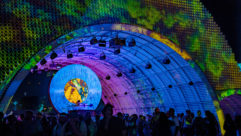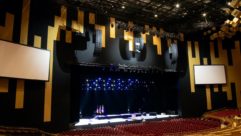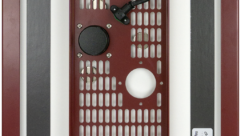
Hotel Takes Sound Approach
Special events, conferences, and conventions can account for as much as 40 percent of hotel revenues, according to the International Hotel & Restaurant Association. The Hilton Brighton Metropole hotel in Brighton, a popular convention and resort city in the southern county of Sussex, England, is one of many hotels around the world that has struggled to keep both its guests and its conventioneers happy when one group needs attention-getting sound from its audio system and the other just wants to get some sleep.
A sound solutionFinal testingDan Daley is a veteran freelance journalist and author, specializing in media and entertainment technology and business sectors. He can be reached at [email protected].
CHALLENGE: Install a hotel sound system capable of providing sufficient audio volume for a variety of events without annoying nearby guests and local residents.
SOLUTION: Take noise measurements to design an appropriate fixed PA system, and equip the room with acoustical and technological treatments for added protection.
Special events, conferences, and conventions can account for as much as 40 percent of hotel revenues, according to the International Hotel & Restaurant Association. The Hilton Brighton Metropole hotel in Brighton, a popular convention and resort city in the southern county of Sussex, England, is one of many hotels around the world that has struggled to keep both its guests and its conventioneers happy when one group needs attention-getting sound from its audio system and the other just wants to get some sleep.
The large Hilton Brighton Metropole hotel features 334 bedrooms, 28 meeting and function rooms, and nine exhibition halls. The largest of the exhibition halls, which measures 158 by 89 feet, is located at the foot of Sussex Heights — a prestigious 26-story apartment block that has shaped the skyline of Brighton since the late 1960s. However, the increasing popularity of the Hilton exhibition halls meant that the risk of noise disturbing local residents had also increased. The desk received complaints from guests, and local residents also began complaining to the city council.
Located in the southern county of Sussex, England, the Hilton Brighton Metropole hotel installed a dedicated house PA system and implemented a soundproofing solution to keep both guests and clients happy.
The Brighton & Hove City Council’s Environmental Health Team contacted the Hilton, which eventually led to a decision to implement a significant soundproofing initiative. The Hilton appointed local acoustic specialists 24 Acoustics to work directly with the Council on a solution. “Our role was first as a technical intermediary between the complainants, represented by the local authorities, and our client, Hilton,” says Steve Gosling, principal consultant of 24 Acoustics. “The Environmental Health Officers didn’t want any more complaints, and the hotel wanted to continue going about its normal business activity without hindrance. We needed to find a solution that kept both parties happy.”
Yet Gosling says the problem was more complex than it sounded. “So much of the problem was structure-borne noise,” he says. “Complainants can be quite a few floors up the apartment block, but they’re directly connected to the hall below by mechanical coupling to the structure of the building, so some noises can be quite irritating. Our first approach was to measure real events and hear what was actually happening for ourselves (see sidebar on page 39). We took average levels within the entertainment area and then visited sites that made complaints where we measured any detectable noise. Eventually we built up a large amount of data on how the building behaved.”
The remediation process ranged from simple to complex. Immediate solutions could be found for some of the more obvious noise leakage points, such as poorly fitted doors or problems relating to unbaffled air conditioning ducts. Generally, these low-cost fixes, such as improving door gaskets, were implemented first.
But a key part of any presentation technology in the convention rooms was portable PA systems, and subsequent testing revealed some concerns about how different PA systems couple with the building structure, as some events attracted complaints while others didn’t. At this stage, Gosling brought in Acoustic Consultant Richard Vivian of Big Sky Audio. “Richard and I have worked on many projects together over a number of years,” Gosling says. “We both own independent acoustic consultancy practices, but combine our resources for larger projects. Our pooled resources in terms of skills, experience, and extensive measurement and monitoring equipment provide an extremely comprehensive service. Big Sky is well known for work in the music and entertainment sector, so Richard’s experience was a valuable addition to the service.”
Two days of dedicated testing followed, with 8 kW of professional PA equipment loaded into an empty hall to play repetitive music tracks and dedicated test signals. During this testing, multiple locations around the site were checked and noise levels were recorded in detail in each area.
“Having control of the noise source allowed us to measure in significantly greater detail than just listening to random music from a real event,” Vivian says. “Some bands turn up with two stacks of PA speakers and cause a problem; others use a distributed or controlled directivity system and don’t cause noise issues. Both may work well in the room where the event is taking place, but will interact in completely different ways with the building structure. That was a real challenge. We weren’t just looking at how loud the music system was, but also the frequency content of the noise source and how the system coupled with the room. Ultimately noise at some frequencies will be more problematic than others. By evaluating this under controlled test conditions we could really build up a picture of exactly what was happening.”
A major challenge was created by the unpredictability of sound sources in the room. Each band, disco, or conference organizer had previously supplied his or her own PA, and the variability in equipment quality, size, position, and EQ meant that noise levels were impossible to predict. Following analysis of all the data collected, it became clear that the only way the hotel could ensure absolute control of the noise within the room was to install a dedicated house PA system. This would mean that future calculations for sound isolation within the structure could be based on a known and predictable system with built-in limiting to ensure maximum permissible levels wouldn’t be exceeded. This also allowed the designers of the new system to specify certain critical settings, such as compression.
TAKING THE NOISE MEASUREMENTS
To control the amplified noise levels that were causing its neighbors to complain, the Hilton Brighton Metropole hotel in Brighton, England, turned to local acoustic specialists 24 Acoustics to devise an effective solution. Steve Gosling, principal consultant at 24 Acoustics, and Acoustic Consultant Richard Vivian of Big Sky Audio took various measurements using Rion NA-72 and Norsonic Nor-118 Type 1 sound level meters.
All of the meters were regularly calibrated against a traceable national standard and calibration was verified before and after a series of measurements. A-weighted sound pressure level (SPL) is measured either instantaneously using a slow meter response to give a figure for SPL in dB (A), or averaged over a period of time to account for fluctuations in the music to give a figure equating to a continuous equivalent level referred to as Leq dB (A).
Additionally, SPLs in the 63 Hz and 125 Hz single-octave bands were specifically analyzed, as these were identified as particularly problematic frequency bands for structure-borne noise. Test noise sources were targeted at structural columns to verify structure-borne paths, and to provide data to compile a matrix of priorities for acoustic treatment.
The audio system includes six Electro-Voice RX 212 full-range speakers chosen by Craig Wiggins, director of Xtreme Audio Visual (which sold most of the gear for the project), powered by three MC2 Audio T 2000 amplifiers and three MC2 Audio T 500 amplifiers.
“Some level control systems that simply cut the power off should only be used in extreme situations,” Vivian says. “A house system with a gentle compression that only comes in when it’s needed is a far more elegant solution. Not only can we control the maximum level, but the room interaction since the speaker positions are fixed and mechanically isolated. The installed system’s precise control means that amplified music levels are now always predictable and controllable. Individual loudspeaker control through the Allen & Heath iDR-8 DSP system enables some loudspeakers in locations that are more sensitive to noise problems to be individually tuned to significantly reduce noise problems elsewhere in the building. We can also be sympathetic to the structure’s resonance characteristics by using subtle EQ that doesn’t detract significantly from the system performance, but also doesn’t get so loud or resonant that it causes neighbors to complain.”
Vivian says that subwoofers were specifically left out of the plan, but could always be added later. Because subs generally need to be boxed for aesthetic reasons, and the stage could be located in two areas of the largest hall, the design team opted against that. Performers who require subs can bring their own units. A similar philosophy was taken with the mixer. “We left that to the incoming production companies,” Vivian says. “We’ve just left line-level wall panels with XLR panel connectors.”
To effectively meet the hotel’s needs, Vivian says the project required a combination of flexible and reliable equipment. “MC2 amplifiers sound great and are extremely reliable, so this was an easy choice for me,” he says. “There were quite a few options for system control, but Allen & Heath offers so much flexibility that I realized the iDR-8 would not only be more than capable to do what we wanted right now, but would also offer the opportunity to expand and modify the system in future. The iDR software interface is very intuitive, and the option to dial in and modify system settings from a remote location offers a really useful facility.”
Wiggins says the Electro-Voice speakers were another important component. “The brief was for a compact, high-power box, operating from six positions to cover the whole floor area in a very large room,” he says. “I’ve used RXs before and was pleased with the results. The rotatable horn offers a very useable coverage pattern, and the box is easy to fly without having to resort to bulky flyware.”
Altogether, the install used 700 meters of Van Damme TourGrade 4-core black speaker cable, 500 meters of the Starquad signal cable, a Van Damme mic XLR panel, six four-pole Neutrik Speakon connectors and 12 two-pole Neutrik Speakon connectors. With the long home runs from the speakers, Wiggins says the cabling choice was critical. “We chose to use Van Damme Starquad signal cable and their tour-grade speaker cable with Neutrik connectors,” he says. “The Starquad cable allowed us to use long cable runs without fear of interference or signal drop.”
In his role as mediator between local authorities and the hotel, Wiggins also needed to reassure both parties that the noise issue would be resolved once and for all, so acoustical treatments were also added to the site. 24 Acoustics specified an upgrade to the existing acoustic cladding around key structural points in the building to help decouple them from the sound generated in the exhibition hall. Gosling specified independent studwork cladding around key structural columns in the building, consisting of an isolated studwork frame, two layers of plasterboard, and a 50-percent fill in the enclosed air gap using mineral wool quilt.
The equipment needed to be installed within strict time constraints imposed by Hilton, which was keen to get the system in as quickly as possible so as not to disrupt scheduled events. The entire installation took four weeks, and the PA system install took two technicians five days to complete. “Including the running of new cables was the most labor-intensive part of our job, as the false ceiling tiles had to be removed and replaced as we went,” Wiggins says.
The total cost of the project came in at slightly more than $100,000. “A key approach on a project like this is to implement the changes that will make the biggest difference first,” Wiggins says. “Should the client decide that further improvements are necessary, these can be addressed in a second stage of works. But fortunately, we didn’t have to go there. It also helped that generic acoustical products were used to reduce cost and enable tight schedules to be met.”
FOR MORE INFORMATION
Allen & Heathwww.allen-heath.co.uk
Electro-Voicewww.electrovoice.com
MC2 Audiowww.mc2-audio.co.uk
Neutrikwww.neutrik.com
Norsonicwww.norsonic.com
Van Dammewww.vdctrading.com
While system tests were considered reliably predictive, Hilton management was a still a bit anxious to see if the new system would actually work as promised. “The pressure is on in a situation like this,” Vivian says. “There’s a big room full of guests, a band that’s rather suspicious of house PA systems, and I knew that at 10 pm there would be a senior officer from the Council walking around outside with a sound level meter.”
It turns out there was little to fear. Throughout the evening Gosling and Vivian communicated by walkie-talkie. Gosling relayed measurements from the surrounding areas, and Vivian reactively tweaked the system settings. “It was only a matter of 30 minutes into the gig before we already had levels set in the room, and the system wasn’t causing problems in the most problematic areas,” Gosling says. “By the time the Council officer arrived to monitor it, the system was performing to his satisfaction and to that of the guests, and no complaints were received from the local residents.”
In the United Kingdom, the government has identified that soundproofing in hotels has historically been less than ideal. For this reason, U.K. Building Regulations — revised in 2003 — now include hotel rooms under the classification of “rooms for residential purposes.” All newly built hotel rooms or rooms converted from another use to a hotel bedroom are now required by law to achieve a minimum standard for soundproofing.
A copy of Approved Document E “Resistance to the passage of Sound” (2003 Edition) published by the Office of the Deputy Prime Minister, is available at www.odpm.gov.uk/stellent/groups/odpm_buildreg/documents/page/odpm_breg_600262.pdf.










